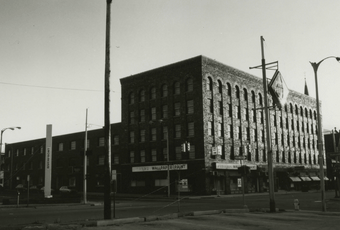William A. Paterson Factory Complex facts for kids
Quick facts for kids |
|
|
William A. Paterson Factory Complex
|
|
 |
|
| Location | 126 E. 3rd St., Flint, Michigan |
|---|---|
| Area | less than one acre |
| Built | 1885 |
| Demolished | 1996 |
| NRHP reference No. | 84001396 |
| Added to NRHP | February 16, 1984 |
The William A. Paterson Factory Complex was a large factory building located at 126 East 3rd Street in Flint, Michigan. It was a very important place for making vehicles. In 1984, it was added to the National Register of Historic Places, which is a list of special historic sites. However, the building was taken down in 1996.
Contents
History of the Paterson Factory
Starting a Business in Flint
William A. Paterson was born in Canada in 1838. He learned how to be a blacksmith, working with metal to make things like horse carriages. He moved to the United States and worked in different places, building wagons and stagecoaches.
In 1869, Paterson came to Flint, Michigan. He started a small shop where he fixed wagons. Soon, he began building his own wagons and buggies. By the 1880s, his company had ten workers. They could build one buggy and one cart every day.
Growing the Factory
In the mid-1880s, Paterson had enough money to build a much bigger factory. He built the first part of this factory in 1885. Once it was finished, his company was the biggest vehicle maker in the area.
Around this time, two important people, William C. Durant and J. Dallas Dort, asked Paterson to make road carts for them. Paterson agreed and soon had orders for over 10,000 carts! To keep up, he quickly made his factory bigger. He added another building in 1885 and built a new one in 1887. Even though Paterson and Durant-Dort later stopped working together, Paterson's company continued to do well and grow.
After a fire in 1894, Paterson rebuilt his factory and made it even larger. He added another building between 1895 and 1897. Then, in 1898, he added more to the original building.
From Buggies to Cars
By 1901, Paterson's company was very successful. It had 350 employees and made more than 23,000 vehicles each year. In 1905, they added another building to the factory.
In 1908, Paterson started making automobiles, which were new at the time. He called them the Paterson Auto Buggy. Paterson cars were made until the 1920s. William A. Paterson himself passed away in 1921. His son, William S. Paterson, took over the business. However, many car companies were joining together to become bigger, and Paterson's company was too small to compete. The company was sold in 1923, and the new owners stopped making Paterson cars.
New Uses and Demolition
In 1926, the factory building was sold. There were plans to turn it into apartments. In 1928, it became the first home of the Flint Institute of Arts, an art museum. Over the years, many different businesses and offices used parts of the building. These included a wallpaper store, a business college, a Social Security office, and even the Internal Revenue Service (IRS).
However, in 1996, a wall at the back of the building fell down. This made the building unsafe, so it had to be torn down. The area where the factory once stood is now a parking lot. A small historical marker, made from bricks saved from the old building, reminds people of the important factory that used to be there.
What the Factory Looked Like
The William A. Paterson Factory Complex was made up of four main buildings. They covered about one-third of a city block.
The oldest building was a single-story shed made of brick and wood. It was likely built in the late 1870s or early 1880s. The next two buildings were three stories tall and made of brick. They were built between 1885 and 1897. These buildings had windows placed evenly between strong brick columns.
The fourth building was built in 1905. This was when Paterson started making cars instead of just buggies. This building was five stories tall and covered with special paving bricks. It also had evenly placed windows and a decorative brick design at the top.

